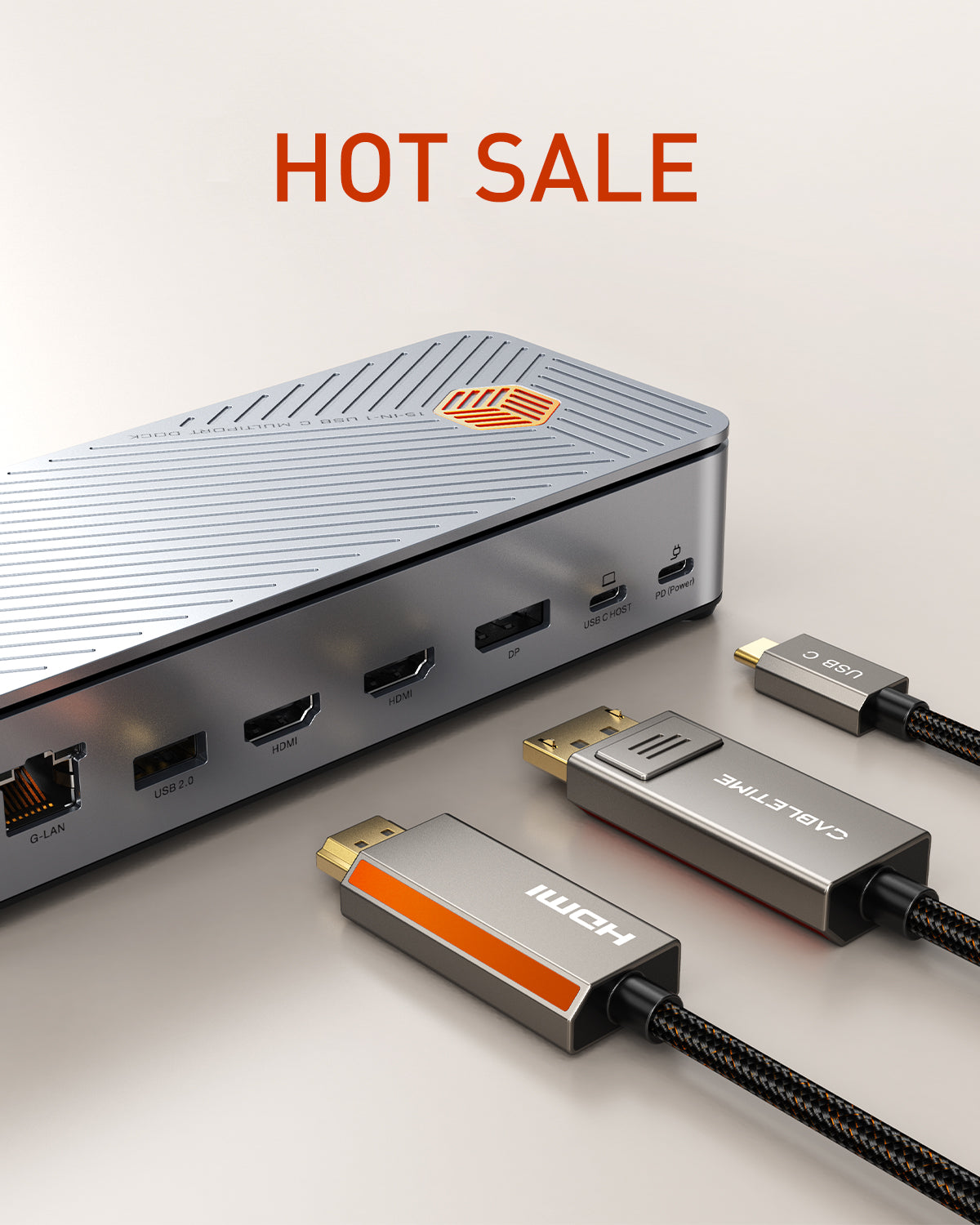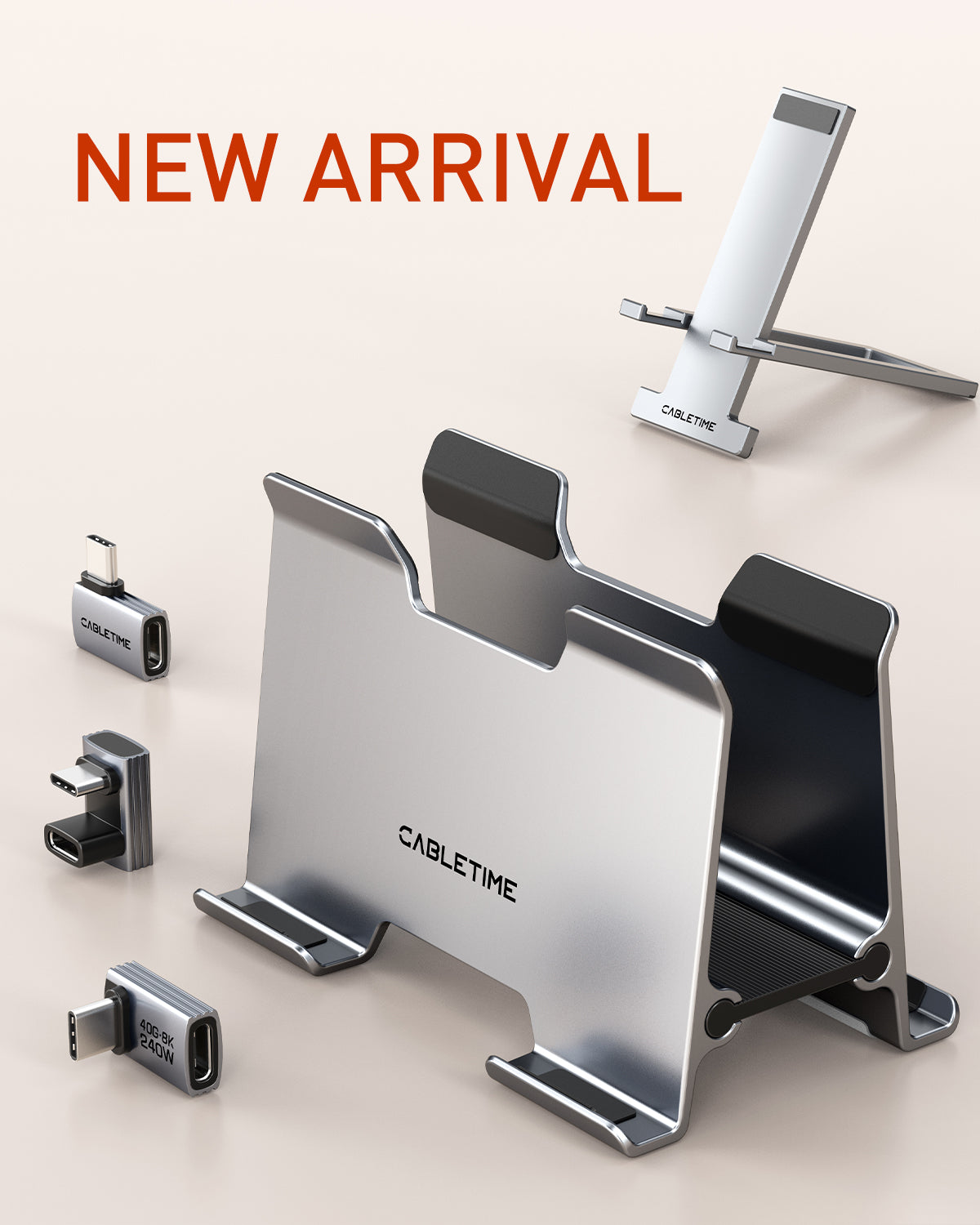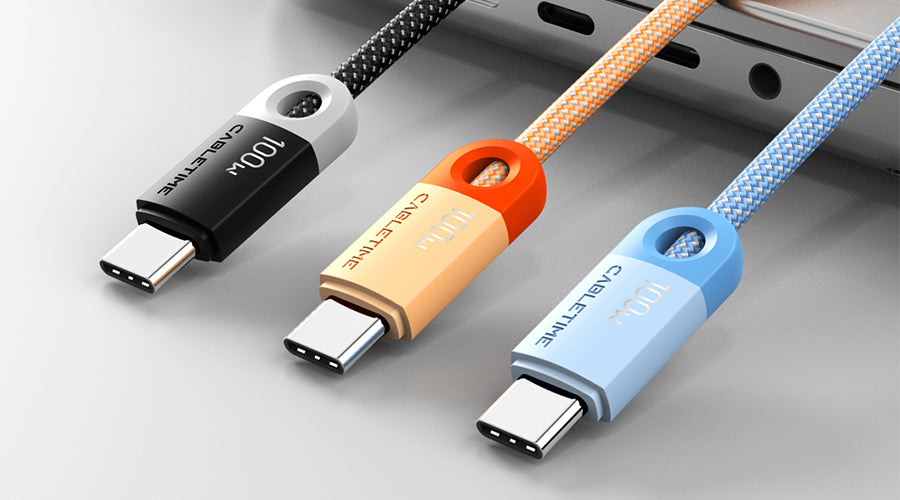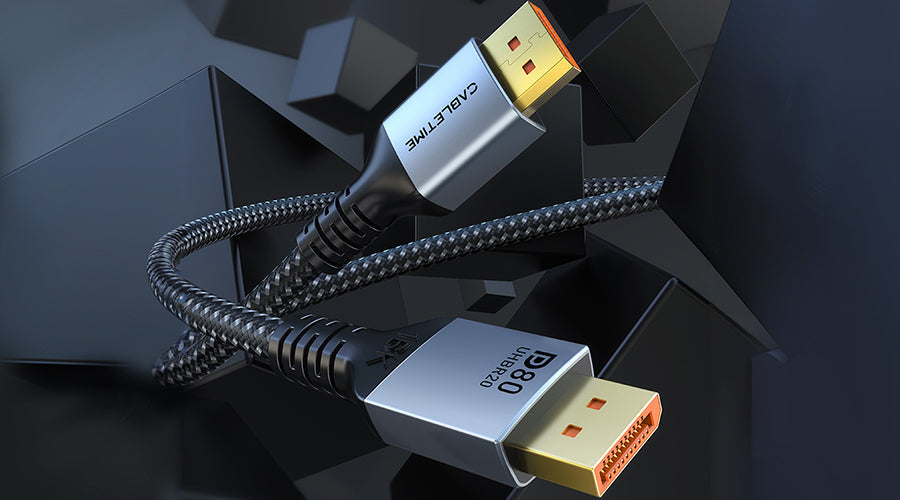คุณรู้หรือไม่ว่าสาย USB-C รุ่นใหม่สามารถจ่ายไฟให้กับอุปกรณ์ขนาด 240W ได้ การซื้อสาย USB-C จากร้านค้าในพื้นที่ของคุณอาจเป็นเรื่องท้าทาย เนื่องจากมีตัวเลือกมากมาย และสาย USB-C ไม่ได้ถูกผลิตมาเท่าเทียมกัน รุ่นใหม่กว่านั้นเข้ากันได้กับรุ่นก่อนหน้า แต่ความสับสนอาจเกิดขึ้นเมื่อคุณเห็นสาย USB-C ที่ออกแบบมาเฉพาะสำหรับการจ่ายไฟ (PD) โปรดจำไว้ว่า ไม่ใช่สาย PD ทั้งหมดที่จะรองรับข้อมูลเท่านั้น สายเคเบิล USB-C PD สามารถรองรับทั้งพลังงานและการส่งข้อมูล แต่ก็มีสายไฟเฉพาะบางเส้นที่ไม่มีความสามารถในการถ่ายโอนข้อมูล
หากคุณต้องการเป็นผู้เชี่ยวชาญด้านสายเคเบิล USB-C และเรียนรู้รายละเอียดที่ซับซ้อนทั้งหมดที่คุณสามารถคุยโวกับเพื่อนๆ ได้ นี่คือคู่มือสำหรับคุณ เราจะแนะนำคุณเกี่ยวกับพื้นฐานของฟีเจอร์ USB-C ขั้นสูงเพื่อให้แน่ใจว่าข้อมูลมาจากแหล่ง USB-IF ที่แท้จริง
สารบัญ
ใครเป็นผู้รับรองมาตรฐาน USB-C?
หากคุณต้องการองค์กรที่รักษามาตรฐาน ให้การรับรอง ส่งเสริมเทคโนโลยี และรับรองการออกใบอนุญาตเพื่อผลิตผลิตภัณฑ์ที่เป็นไปตามข้อกำหนด ก็เป็นเช่นนั้น USB-IF (USB Implementers Forum) ก่อตั้งเมื่อปี 1995 ถือเป็นผู้มีบทบาทสำคัญในเทคโนโลยี USB USB-IF เป็นองค์กรไม่แสวงหากำไรที่ทำงานร่วมกับองค์กรต่างๆ มากมาย โดยมีสมาชิกที่มีชื่อเสียง ได้แก่ Apple Inc., HP, Intel, Renesas, STMicroelectronics และ Texas Instruments
วิธีการสังเกตสาย USB-C
ขั้วต่อของสายเคเบิลที่เสียบเข้ากับเครื่องชาร์จ คอมพิวเตอร์ สมาร์ทโฟน แท็บเล็ต หรืออุปกรณ์อื่น ๆ เรียกว่าพอร์ตUSB-C มีขั้วต่อรูปวงรีที่โดดเด่นซึ่งสามารถเชื่อมต่อได้จากทุกทิศทางและมักเรียกว่าขั้วต่อแบบกลับด้านได้ สายเคเบิลอาจมีขั้วต่อ USB-A ที่ปลายด้านหนึ่งและขั้วต่อ USB-C ที่ปลายอีกด้านหนึ่ง สายเคเบิล USB-C สมัยใหม่มีขั้วต่อประเภท USB-C ที่ปลายทั้งสองด้าน

ประเภทและฟังก์ชันของสาย USB-C

USB-IF มีหน้าที่ควบคุมมาตรฐานของสายเคเบิล USB-C ตามมาตรฐานแล้ว ฟังก์ชันและประเภทของ USB-C สามารถแบ่งออกตามวัตถุประสงค์ได้ สายเคเบิลบางประเภทสามารถรองรับวิดีโอ เสียง พลังงาน และการส่งข้อมูล ในขณะที่บางประเภทมีไว้สำหรับการชาร์จไฟเท่านั้น มาเริ่มสำรวจกันเลย!
สายข้อมูล
สายเคเบิล USB-C เริ่มต้นจากสายเคเบิลข้อมูล จุดประสงค์คือเพื่อให้แน่ใจว่าการแบ่งปันข้อมูลระหว่างอุปกรณ์หลายเครื่องนั้นสะดวกสบายด้วยขั้วต่อแบบกลับด้านที่แข็งแรง มีสายเคเบิลข้อมูล USB-C มากมายและรายละเอียดที่สำคัญ เช่น จำนวนพินและสาย ในฐานะผู้ใช้ที่ต้องการซื้อสายเคเบิล USB-C คุณสามารถสังเกตเห็นความแตกต่างระหว่างเวอร์ชันต่างๆ ได้ด้วยความรู้ที่จำเป็น ส่วนใหญ่แล้ว คุณต้องพึ่งพาสิ่งที่บรรจุภัณฑ์ระบุไว้เกี่ยวกับสายเคเบิลข้อมูล USB-C
มีสายเคเบิลข้อมูล USB-C หลายเวอร์ชันที่รองรับการส่งวิดีโอ สายเคเบิล USB-C รุ่นใหม่สามารถรองรับโปรโตคอลต่างๆ เช่น DisplayPort, MHL และ HDMI (เฉพาะ Thunderbolt 3 และ 4) หากคุณมีการ์ดจอและจอภาพที่มีพอร์ตเชื่อมต่อ USB-C คุณสามารถใช้สายเคเบิลข้อมูล USB-C เพื่อสร้างการเชื่อมต่อระหว่างทั้งสองได้ จอภาพของคุณสามารถทำงานร่วมกับโปรโตคอล HDMI และ DisplayPort ได้ ขึ้นอยู่กับเวอร์ชันที่ฮาร์ดแวร์ของคุณรองรับ มีสายเคเบิล USB หลายเวอร์ชัน เช่น USB4.0 V2.0 หรือ USB2.0 อย่างไรก็ตาม เราจะกล่าวถึงสายเคเบิลข้อมูลและอัตราการถ่ายโอนข้อมูลอย่างละเอียดในส่วนถัดไปของบทความนี้
สายไฟอย่างเดียว

ปัจจุบันสายเคเบิล USB-C แบบกลับด้านสามารถรองรับกำลังไฟได้สูงถึง 240W USB-IF กำหนดมาตรฐานสายเคเบิลเหล่านี้และรับรองความถูกต้องด้วยวิธีการต่างๆ สายเคเบิล USB-C มีเวอร์ชันต่างๆ และเวอร์ชัน USB 2.0 รุ่นแรกสุดสามารถจ่ายไฟได้เพียง 2.5W เท่านั้น เวอร์ชัน USB แต่ละเวอร์ชันจะมีจำนวนพินที่แตกต่างกันและสามารถจ่ายไฟได้ต่างกัน สายเคเบิลจ่ายไฟซีรีส์ USB PD ล่าสุดสามารถจ่ายไฟได้เท่านั้นและไม่สามารถส่งข้อมูลได้
สายเคเบิล USB-IF Power Delivery 3.1 Type-C รุ่นล่าสุดสามารถจ่ายไฟได้มากถึง 240W สายเคเบิลสามารถสื่อสารกับอุปกรณ์และแลกเปลี่ยนข้อมูล เช่น แรงดันไฟและกระแสไฟที่รองรับ อุปกรณ์จะส่งความต้องการพลังงานตามสถานะปัจจุบัน เครื่องชาร์จมาตรฐาน USB สามารถเริ่มจ่ายไฟและเปลี่ยนแรงดันไฟและแอมแปร์ตามอุณหภูมิของอุปกรณ์ ความสมบูรณ์ของแบตเตอรี่ และด้านอื่นๆ สายเคเบิล USB-C ที่ไม่ได้มาตรฐานไม่สามารถดำเนินการตามขั้นตอนเหล่านี้ได้ ซึ่งอาจทำให้เกิดความไม่เสถียรหรือปัญหาการชาร์จช้า
สายไฮบริด: สายข้อมูล การชาร์จ และการส่งผ่านวิดีโอ

ปัจจุบันโทรศัพท์ แล็ปท็อป IoT และอุปกรณ์อื่นๆ ส่วนใหญ่มีพอร์ต USB-C เนื่องมาจากการออกแบบที่ได้มาตรฐานและการนำแนวทางปฏิบัติระดับสากลมาใช้ เนื่องจากเครื่องชาร์จมีส่วนสำคัญในการก่อให้เกิดขยะทางเทคโนโลยี คณะมนตรีแห่งสหภาพยุโรป (EU) จึงได้ออกคำสั่ง คำสั่ง 2022/2380 ระบุว่าสมาร์ทโฟนทั้งหมดจะต้องใช้การชาร์จ USB-C จนถึงวันที่ 28 ธันวาคม 2024 ในทำนองเดียวกัน ยังได้กำหนดเส้นตายสำหรับการชาร์จแล็ปท็อปและการถ่ายโอนข้อมูลภายในวันที่ 28 เมษายน 2026 ซึ่งเป็นจุดเริ่มต้นของการกำหนดมาตรฐานเทคโนโลยี USB-C
มีสาย USB-C ที่รองรับไฮบริด โดยสามารถทำงานร่วมกับเครื่องชาร์จที่รองรับ USB-C PD มาตรฐานและรองรับการแลกเปลี่ยนข้อมูลผ่าน USB กับอุปกรณ์ที่เข้ากันได้ สายข้อมูลและสายชาร์จเหล่านี้เหมาะอย่างยิ่งสำหรับผู้ใช้สมาร์ทโฟนทั่วไป ความคล่องตัวของสายเหล่านี้เปิดโอกาสให้มีทางเลือกในการใช้งานในแอปพลิเคชันต่างๆ ตัวอย่างที่ครบครันที่สุดอย่างหนึ่งคือการใช้จอภาพ จอภาพบางรุ่นสามารถทำงานด้วยการเชื่อมต่อ USB-C เพียงเส้นเดียว โดยไม่ต้องใช้สายสองเส้นในการจัดการสายเคเบิล USB-C และโปรโตคอลที่มีอยู่จะถ่ายโอนพลังงาน ข้อมูล เสียง และวิดีโอ
สาย USB-C สำหรับการถ่ายโอนข้อมูล
มาสำรวจความเร็วการถ่ายโอนข้อมูลของสาย USB-C และโปรโตคอลที่รองรับกันอย่างละเอียดมากขึ้น การทำความเข้าใจเวอร์ชันเหล่านี้จะช่วยให้คุณเลือกสายที่เหมาะกับอุปกรณ์ของคุณได้
ช่องส่งและรับ USB-C
ขั้วต่อ USB-C สมัยใหม่มีพิน 24 พินที่ทำหน้าที่เชื่อมต่อ โดยแต่ละพินใช้สำหรับส่งข้อมูลและจ่ายไฟ พิน 1 คู่จะทำหน้าที่เป็นช่องทางการสื่อสาร การสื่อสารข้อมูลต้องใช้พินอย่างน้อย 2 พินจึงจะสร้างการเชื่อมต่อได้ การเพิ่มจำนวนช่องทางจะช่วยเพิ่มความเร็ว เนื่องจากข้อมูลขนาดใหญ่สามารถเดินทางพร้อมกันได้จากพินจำนวนมาก

USB 3.1 มีช่องทางการเชื่อมต่อข้อมูลที่แตกต่างกัน โดย USB 3.1 จะใช้ช่องทาง TX (ช่องทางส่งข้อมูล) และช่องทาง RX (ช่องทางรับ) หนึ่งช่องทาง เพื่อส่งข้อมูลด้วยความเร็ว 10 Gbps ในขณะที่ USB 3.2 จะใช้ช่องทาง TX และ RX ทั้งสี่ช่องทางที่มีอยู่เพื่อส่งข้อมูลด้วยความเร็ว 20 Gbps
ตัวอย่างเช่น USB4 Gen 3×2 หมายความว่าชุดอุปกรณ์และพอร์ตรองรับเวอร์ชัน USB4 Gen3 ซึ่งใช้ช่องทางสองช่องทางสำหรับการส่งข้อมูล 40Gbps ในทำนองเดียวกัน USB USB 3.2 Gen 1×1 หมายความว่าสามารถทำงานร่วมกับเวอร์ชัน USB 3.2 Gen 1 ซึ่งใช้ช่องทางหนึ่งสำหรับการส่งข้อมูลความเร็ว 5Gbps ได้
คำอธิบายเวอร์ชันและโปรโตคอลของ USB-C
USB-C รองรับเวอร์ชันต่างๆ กัน โดยแต่ละเวอร์ชันจะมีวิธีการสื่อสารกับอุปกรณ์ส่งสัญญาณที่แตกต่างกันออกไป บางเวอร์ชันสามารถส่งสัญญาณวิดีโอ เสียง และข้อมูลได้ ในขณะที่บางเวอร์ชันสามารถส่งสัญญาณได้เฉพาะข้อมูลเท่านั้น ความเร็วในการส่งข้อมูลของสายเคเบิลจะขึ้นอยู่กับเวอร์ชันต่างๆ ดังต่อไปนี้:
ยูเอสบี 2.0
ปีเปิดตัว : 2000
ความเร็วในการถ่ายโอนข้อมูล: 480 Mbps
เวอร์ชันนี้เปิดตัวในปี 2000 แต่ไม่มีขั้วต่อ USB-C ในกลุ่มผลิตภัณฑ์ เนื่องจาก USB-IF เปิดตัวขั้วต่อ USB-C ในปี 2014 อย่างไรก็ตาม ควรสังเกตว่าเวอร์ชัน USB 2.0 มีความเร็วสูงสุดที่ 480Mbps เวอร์ชันเหล่านี้รองรับขั้วต่อ USB-A, USB-B, Mini-USB B และ Micro-USB B

ยูเอสบี 3.2
ปีเปิดตัว : 2017
ความเร็วในการถ่ายโอนข้อมูล: 20 Gbps
USB 3.1 เป็นเวอร์ชันแรกที่รองรับการเชื่อมต่อ USB-C อย่างไรก็ตาม การใช้งานความสามารถของขั้วต่อ USB-C อย่างเต็มที่เกิดขึ้นในภายหลังในปี 2017 ด้วย ยูเอสบี 3.2 เวอร์ชัน USB 3.2 Gen 2x2 SuperSpeed 20Gbps ช่วยเพิ่มความเร็วในการถ่ายโอนข้อมูลได้ อย่างไรก็ตาม มีเงื่อนไขอยู่ว่าเมนบอร์ดหรืออุปกรณ์ต่างๆ มักระบุความเร็วในการถ่ายโอนข้อมูลว่าเป็น USB 3.2 Gen 2x2 SuperSpeed 20Gbps ซึ่งหมายความว่าใช้ช่องเชื่อมต่อ USB-C สองช่องตามที่อธิบายไว้ก่อนหน้านี้ เพื่อให้ได้ความเร็ว 20Gbps ช่องเชื่อมต่อ USB 3.2 ช่องเดียวสามารถให้ความเร็วได้สูงถึง 10Gbps
คุณจะสังเกตเห็นว่าเวอร์ชัน USB กล่าวถึงรุ่นต่างๆ เช่น USB 3.2 Gen1 และ USB 3.2 เจเนอเรชั่น 2สิ่งเหล่านี้แสดงถึงความเร็วที่อุปกรณ์สามารถเชื่อมต่อได้และความเข้ากันได้กับเวอร์ชันเก่า อย่างไรก็ตาม สายรองรับ USB 3.2 จะใช้งานได้กับสายข้อมูลทั้งสองแบบ เวอร์ชันนี้มาพร้อมกับการรองรับโปรโตคอลสำหรับสิ่งต่อไปนี้:
- ระบบจ่ายไฟผ่าน USB (USB-PD)
- ดิสเพย์พอร์ต
- สายฟ้า
- PCIe เจเนอเรชั่น 3
- ยูเอสบีออดิโอ
- วิดีโอ USB
ยูเอสบี 4.0
ปีเปิดตัว : 2019
ความเร็วในการถ่ายโอนข้อมูล: 20 Gbps
USB 4.0 เป็นตัวเลือกที่เร็วที่สุดและอเนกประสงค์ที่สุดสำหรับอุปกรณ์ยุคใหม่ โดยให้การเชื่อมต่อแบบสองทิศทาง 40 Gbps และเข้ากันได้กับ USB 3.2 และ USB 2.0 (พร้อมอะแดปเตอร์) ด้วยโปรโตคอล DP 2.0 USB 4 จึงสามารถแสดงผล 8K 60Hz หรือหน่วยแสดงผล 16K ถึง 60Hz ได้ ความเร็วของ USB 4.0 เวอร์ชันนี้ขึ้นอยู่กับความยาวของสายเคเบิล จึงสามารถทำงานได้ที่ 40Gbps ด้วยสายเคเบิลยาว 1 เมตร และ 20Gbps สำหรับสายเคเบิลที่ยาวกว่า โลโก้ USB สำหรับ USB 40 คือ “20” หรือ “40” ต่อไปนี้คือโปรโตคอลที่เวอร์ชัน USB 4.0 รองรับ:
- การจ่ายพลังงานผ่าน USB (USB-PD 3.1)
- ดิสเพย์พอร์ต 2.0
- ธันเดอร์โบลต์ 4.0
- PCIe เจเนอเรชั่น 4
- ยูเอสบีออดิโอ
- วิดีโอ USB
ความแตกต่างระหว่างการชาร์จและการถ่ายโอนข้อมูลด้วยสาย USB-C

ผู้ผลิตสายเคเบิลทุกรายจะกล่าวถึงสายเคเบิลว่าเป็นสายชาร์จหรือสายข้อมูล การเข้าใจว่าสายเคเบิลทั้งหมดสามารถจ่ายไฟและส่งข้อมูลได้นั้นถือเป็นสิ่งสำคัญ อย่างไรก็ตาม สายเคเบิลบางประเภทสามารถให้ความเร็วในการถ่ายโอนข้อมูลและประสิทธิภาพที่สูงกว่าสายเคเบิลประเภทอื่น นั่นเป็นเพราะสายไฟภายในและคุณสมบัติที่แตกต่างกัน ต่อไปนี้คือความแตกต่างที่สำคัญบางประการที่คุณควรทราบระหว่างสายเคเบิลทั้งสองประเภทนี้:
การชาร์จสาย USB-C
ความแตกต่างหลักระหว่างสายชาร์จกับสายข้อมูลคือจำนวนพินที่ใช้ในการทำงาน ขั้วต่อ USB-C มาตรฐานมีพิน 24 พิน โดย 16 พินใช้สำหรับถ่ายโอนข้อมูล 4 พินสำหรับจ่ายไฟ และ 4 พินสำหรับกราวด์ การซื้อสายชาร์จเฉพาะจะมีพินเพียง 4 พินเพื่อลดต้นทุนและรับประกันความทนทาน
อย่างไรก็ตาม ผู้ผลิตบางรายนำเสนอสายชาร์จที่มีสายหนากว่าสำหรับเชื่อมต่อพินไฟและสายบางกว่าสำหรับพินข้อมูล วิธีนี้ทำให้ความเร็วในการถ่ายโอนข้อมูลช้าลงแต่จ่ายไฟได้สูง เช่น 240W จากเครื่องชาร์จ USB PD 3.1 สายชาร์จมาพร้อมกับการรองรับ USB-PD ซึ่งแบรนด์นี้มักจะระบุไว้บนบรรจุภัณฑ์ สายเคเบิลเหล่านี้โดยทั่วไปจะหนากว่าและประกอบด้วยชิป E-marker หากไม่มีชิป E-marker โปรโตคอล USB4 จะไม่จ่ายไฟ 240W หรือทำงานในโหมดแรงดันไฟฟ้าแปรผัน สายชาร์จที่รองรับ USB PD 3.1 รุ่นล่าสุดจะมีลักษณะดังต่อไปนี้:
USB PD 3.1 สำหรับการจ่ายพลังงาน
- ระดับแรงดันไฟฟ้า: รองรับ 12V, 28V, 36V และ 48V
- กำลังขับ: สามารถจ่ายไฟได้ 100W, 140W, 180W หรือ 240W
- แรงดันไฟฟ้าแปรผัน: ช่วยให้สามารถปรับแรงดันไฟฟ้าให้ตรงตามข้อกำหนดของอุปกรณ์ได้
- พลังงานแบบสองทิศทาง: ช่วยให้อุปกรณ์สามารถชาร์จซึ่งกันและกัน
- การจัดการพลังงาน: จัดการการจ่ายพลังงานระหว่างอุปกรณ์หลายเครื่อง
สายข้อมูล USB-C
ในทางกลับกัน สายเคเบิลข้อมูลจะมีพินจำนวนมากกว่า สายเคเบิล USB 4.0 รุ่นใหม่จะมีพินทั้งหมด 24 พินเพื่อให้ส่งข้อมูลด้วยความเร็วสูงและจ่ายไฟได้ปานกลาง สายเคเบิลไฮบริดทั่วไปที่ใช้โปรโตคอล Thunderbolt 4 สามารถจ่ายไฟได้ 100W พร้อมความเร็วในการถ่ายโอนข้อมูล 40Gbps สายเคเบิลเหล่านี้มีความอเนกประสงค์อย่างเหลือเชื่อและให้พลังงานเพียงพอสำหรับชาร์จอุปกรณ์อิเล็กทรอนิกส์สมัยใหม่ ต่อไปนี้คือคุณสมบัติสูงสุดที่เป็นไปได้ของสายเคเบิลข้อมูล Type-C ที่ใช้งานได้หลากหลายที่สุด:
สาย USB-C Thunderbolt 4
การถ่ายโอนข้อมูล: 40 Gbps
กำลังส่ง: 100W
ความละเอียดการแสดงผล: 8K@60Hz- 4K@120Hz, คู่ 4K@60Hz
ความเข้ากันได้: Thunderbolt 4, Thunderbolt 3, USB 4, USB 3.2, USB 3.1, USB 2.0
ขั้วต่อ: USB-C
การเชื่อมต่อแบบเดซี่เชน: รองรับการเชื่อมต่อแบบเดซี่เชนกับอุปกรณ์ Thunderbolt สูงสุด 6 อุปกรณ์
ใบรับรอง: ได้รับการรับรองจาก Intel
วิธีเลือกสาย USB-C ที่เหมาะสม
การซื้อสายเคเบิลที่เกินความจำเป็นสำหรับความต้องการในชีวิตประจำวันอาจเพิ่มภาระให้กับงบประมาณของคุณ เพื่อให้แน่ใจว่าคุณจะได้สายเคเบิล USB-C ที่เข้ากันได้มากที่สุด ให้ปฏิบัติตามแนวทางสามขั้นตอนเหล่านี้ คุณมีความรู้ที่จำเป็นในการทำความเข้าใจคำศัพท์บางคำในคู่มือนี้แล้ว
ขั้นตอนที่ 1: เข้าถึงอุปกรณ์และข้อกำหนดของคุณ
เริ่มต้นด้วยการประเมินความต้องการของคุณ ขั้นแรก คุณจะต้องตรวจสอบเวอร์ชันที่อุปกรณ์ของคุณรองรับ มองหาสัญลักษณ์ดังที่แสดงในภาพด้านล่างเพื่อค้นหาเวอร์ชันที่ถูกต้องสำหรับอุปกรณ์ของคุณ:

USB-C กลายเป็นมาตรฐานในแล็ปท็อป สมาร์ทโฟน แท็บเล็ต และกล้อง ในขณะที่อุปกรณ์พกพาส่วนใหญ่ใช้ USB 2.0 หรือ 31. แล็ปท็อปส่วนใหญ่มักมี USB 4 หรือ Thunderbolt 4 สำหรับการถ่ายโอนข้อมูลและพลังงานสูง ใช้สายเคเบิลที่มีคุณภาพเพื่อให้มั่นใจถึงความเข้ากันได้และประสิทธิภาพ
ขั้นตอนที่ 2: คุณต้องการสายข้อมูลหรือสายชาร์จหรือไม่
คุณต้องการสายเคเบิลถ่ายโอนข้อมูลความเร็วสูงหรือไม่? คุณจะใช้สายเคเบิลนี้เพื่อถ่ายโอนข้อมูลหรือชาร์จข้อมูลบ่อยแค่ไหน? หลังจากตอบคำถามเหล่านี้แล้ว คุณสามารถตัดสินใจได้ว่าจะเลือกสายเคเบิลข้อมูลหรือสายชาร์จ ต่อไปนี้คือประเภทของสายเคเบิลบางส่วนที่คุณอาจพบเมื่อตัดสินใจซื้อ:
- สาย USB-C พร้อมชิป E-Marker: จำเป็นสำหรับสาย USB 4 ที่รองรับการจ่ายไฟเกิน 3A
- สาย USB-C พร้อมชิป Cypress ที่ได้รับการรับรองจาก Intel: จำเป็นสำหรับอินเทอร์เฟซ Thunderbolt 4 และการจัดการพลังงานที่เหนือกว่า
- สายชาร์จแบบพลังงานอย่างเดียว: อุปกรณ์เหล่านี้มีไว้สำหรับอุปกรณ์ที่ต้องการพลังงานน้อยกว่า 3A และไม่จำเป็นต้องมีการถ่ายโอนข้อมูล
- สายข้อมูลและสายชาร์จแบบดั้งเดิม: เหมาะสำหรับอุปกรณ์ที่ต้องการพลังงานน้อยกว่า 3A และการถ่ายโอนข้อมูลที่จำเป็น
ขั้นตอนที่ 3: มองหาความถูกต้องแท้จริง
อย่าหลงเชื่อคำโฆษณาและบรรจุภัณฑ์ของตลาด สายไฟบางเส้นโฆษณาว่าจ่ายไฟได้ 240W โดยไม่ต้องใช้ชิป E-marker แต่ตัวเครื่องจะไม่ตรวจจับสายไฟว่าส่งไฟได้สูงหากไม่มีชิป นอกจากนี้ ควรระวังสายไฟ USB-C ที่มีราคาถูกอย่างน่าสงสัย ซึ่งอาจไม่มีส่วนประกอบที่จำเป็น เลือกสายไฟที่มีคุณสมบัติและรายการความเข้ากันได้ที่ชัดเจน ต่อไปนี้คือสิ่งที่ต้องพิจารณาเพื่อตรวจสอบว่าสายไฟเป็นของแท้หรือไม่:
- โลโก้อย่างเป็นทางการ: ตรวจสอบโลโก้ USB-IF และ Thunderbolt บนบรรจุภัณฑ์และขั้วต่อ
- การรับรอง USB-IF: ตรวจสอบความถูกต้องของสายเคเบิลบนเว็บไซต์ USB-IF ใน “USB-IF Certified TID”
- สร้างคุณภาพ:ตัวเรือนพลาสติกคุณภาพต่ำมักบ่งชี้ว่าเป็นสายเคเบิลปลอม
- ชิปอีมาร์กเกอร์: สายเคเบิลที่รองรับมากกว่า 3A ควรมีชิป E-Marker
ผู้เชี่ยวชาญที่ต้องการสายเคเบิลความเร็วสูง ของแท้ ทนทาน เชื่อถือได้ และใช้งานได้ยาวนานสามารถเลือกใช้ผลิตภัณฑ์ CABLETIME ได้ ผลิตภัณฑ์ของบริษัทสร้างขึ้นจากวัสดุเกรดสูงสุดและรับรองความถูกต้อง ผลิตภัณฑ์แต่ละชิ้นมี TID ที่ผ่านการรับรอง USB-IF ซึ่งสามารถค้นหาได้ในฐานข้อมูล USB-IF สายเคเบิลของบริษัทผ่านการทดสอบปลั๊กมากกว่า 10,000 ครั้งและการทดสอบการดัดงอมากกว่า 2,000 ครั้งเพื่อให้มั่นใจถึงความน่าเชื่อถือ เยี่ยมชมกลุ่มผลิตภัณฑ์ CABLETIME สาย USB-C เพื่อการรวบรวมสุดยอดผลิตภัณฑ์ระดับไฮเอนด์อันแท้จริง
บทสรุปและข้อเสนอแนะ
สาย USB-C ถือเป็นขั้วต่อที่ใช้งานได้หลากหลายที่สุดอย่างไม่ต้องสงสัย เนื่องจากมีความทนทานและให้ตัวเลือกการเชื่อมต่อแบบสากล ขั้วต่อขนาดกว้าง 8.4 มม. สามารถถ่ายโอนเสียง วิดีโอ ข้อมูล และพลังงานได้ อย่างไรก็ตาม สายเคเบิลประเภทต่างๆ จะถ่ายโอนข้อมูลระหว่างขั้วต่อ สายเคเบิลบางประเภทเน้นข้อมูล ในขณะที่สายเคเบิลประเภทอื่นให้การจ่ายพลังงานที่ยอดเยี่ยม ควรพิจารณาสถานการณ์การใช้งานและข้อกำหนดอุปกรณ์ของคุณเสมอ ก่อนที่จะเลือกสายเคเบิลข้อมูล
คุณสามารถเลือกใช้สายเคเบิล Thunderbolt 4 ซึ่งให้พลังงาน 100W พร้อมการเชื่อมต่อ 40Gbps หรือจะเลือกใช้สายเคเบิล USB PD 3.1 ที่สามารถจ่ายพลังงานได้มากถึง 240W ก็ได้ อย่างไรก็ตาม คุณจะต้องตรวจสอบว่าสายเคเบิล Thunderbolt มีชิป Intel หรือไม่ และสายเคเบิล USB PD มีชิป e-marker หรือไม่ ควรมองหาโลโก้และใบรับรองที่เป็นของแท้ก่อนตัดสินใจซื้อเสมอ
5 คำถามที่เกี่ยวข้องที่ผู้อ่านอาจถาม
ฉันสามารถใช้สาย USB-C เพื่อชาร์จแล็ปท็อปได้หรือไม่
คุณสามารถใช้สาย USB-C เพื่อชาร์จแล็ปท็อปได้ แต่สาย USB-C ไม่ได้ถูกผลิตมาเท่าเทียมกันทั้งหมด ดังนั้นคุณต้องตรวจสอบความสามารถในการจ่ายไฟของสาย USB-C สายที่รองรับ USB PD และชิป E-Marker เหมาะอย่างยิ่งสำหรับการจ่ายไฟให้กับแล็ปท็อป สาย USB-C นี้มีการป้องกันหลายชั้นเพื่อปกป้องอุปกรณ์และเครื่องชาร์จของคุณให้ปลอดภัย
ความแตกต่างระหว่าง USB-C กับ Thunderbolt 4 คืออะไร?
Thunderbolt 3 ใช้ขั้วต่อแบบเดียวกับสาย USB-C อย่างไรก็ตาม สาย Thunderbolt ได้รับการรับรองจาก Intel ในขณะที่สาย USB ได้รับการรับรองจาก USB-IF Thunderbolt 4 เป็นการเชื่อมต่อ USB-C รุ่นล่าสุดและเร็วที่สุดสำหรับการถ่ายโอนข้อมูล 40Gbps ด้วยแหล่งจ่ายไฟ 100W
สาย USB-C ทั้งหมดเข้ากันได้กับอุปกรณ์ทั้งหมดหรือไม่
สาย USB-C ทั้งหมดจะทำงานกับอุปกรณ์ทุกชนิดได้ แต่สายเหล่านี้อาจทำให้เกิดข้อจำกัดในการส่งข้อมูล เสียง วิดีโอ หรือพลังงาน สาย USB-C รุ่นเก่าต้องมีความหนาของสายและชิปที่ถูกต้องเพื่อรองรับเทคโนโลยีล่าสุด เช่น Thunderbolt หรือ USB PD ควรมองหาโลโก้บนสายและพอร์ตอุปกรณ์ของคุณเสมอเพื่อตัดสินใจว่าเวอร์ชันใดเข้ากันได้มากที่สุด อย่างไรก็ตาม สาย Thunderbolt 4 จะครอบคลุมความต้องการของอุปกรณ์ส่วนใหญ่ ยกเว้นการจ่ายพลังงาน 240W หากต้องการทำเช่นนี้ คุณต้องใช้สาย USB-C ที่รองรับ USB PD 3.1
ฉันจะบอกได้อย่างไรว่าสาย USB-C เป็นความเร็วสูง?
สาย USB-C จากแบรนด์แท้มีโลโก้อย่างเป็นทางการและใบรับรองจาก USB-IF ผู้ใช้ค้นหาได้ในเว็บไซต์อย่างเป็นทางการของ USB-IF โลโก้แต่ละอันแสดงถึงความเร็วที่รับประกัน USB 4.0 ที่มีโลโก้ “40” หมายความว่าสามารถถ่ายโอนข้อมูลด้วยความเร็ว 40Gbps
สาย USB-C จะเสื่อมสภาพตามกาลเวลาหรือไม่?
สายเคเบิล USB-C อาจสึกหรอลงได้เมื่อเวลาผ่านไป เนื่องจากการเสียบและถอดปลั๊กอยู่ตลอดเวลาอาจทำให้ขั้วต่อโลหะสูญเสียความแข็งแรง วัสดุอาจหลุดออก ทำให้ขั้วต่อบางลงและหยุดเชื่อมต่อ ตรวจสอบให้แน่ใจว่าคุณซื้อสายเคเบิลแบรนด์ดังจากผู้ผลิตที่มีชื่อเสียง เช่น CABLETIME ซึ่งทดสอบผลิตภัณฑ์ด้วยการทดสอบปลั๊กมากกว่า 10,000 ครั้งและการทดสอบการดัดงอมากกว่า 2,000 ครั้ง






1 ความคิดเห็นเกี่ยวกับ
kathryn buckley cowan
Hello,
I’m trying to replace charging cable for a sharper image massager. it says: plus USB-C charging cable into USB-C adapter. Can you help me ideintify what I might purchase from you?
thanks much, Kathryn
ทิ้งข้อความไว้
เว็บไซต์นี้ได้รับการคุ้มครองโดย hCaptcha และมีการนำนโยบายความเป็นส่วนตัวของ hCaptcha และข้อกำหนดในการใช้บริการมาใช้